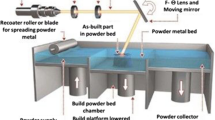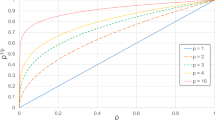Abstract
In this paper, a stable node-based smoothed finite element method (SNS-FEM) is presented for analyzing metal forming problems using linear triangular or tetrahedral elements. In present method, the numerical integration domains are approximately circular or spherical regions of the node-based smoothing domains generated by the node-based smoothed finite element method (NS-FEM). Four or six supplementary integration points, which are symmetrically located at the crossover points of the region and the coordinate axis, are employed for each node to form the stabilization items associated with the variance of smoothed shape function gradient. Through this operation without the introducing of any uncertain parameter, the SNS-FEM not only significantly cures the temporal instability of NS-FEM but also performs better in effectiveness and efficiency than FEM, which is well validated by several numerical examples containing benchmark cases. Additionally, a simple but effective contact algorithm including contact searching and contact force computation is presented.















Similar content being viewed by others
References
Belytschko T, Liu WK, Moran B, Elkhodary KI (2014) Nonlinear finite elements for continua and structures, 2nd edn. Wiley, West Sussex
Kobayashi S, Oh SI, Altan T, Chaudhary A (1990) Metal forming and the finite-element method. J Mater Shaping Technol 8:65
Liu WK, Hao W, Chen Y, Jun S, Gosz J (1997) Multiresolution reproducing kernel particle methods. Comput Mech 20:295–309
Gosz J, Liu WK (1996) Admissible approximations for essential boundary conditions in the reproducing kernel particle method. Comput Mech 19:120–135
Chen JS, Roque CMOL, Pan C, Button ST (1998) Analysis of metal forming process based on meshless method. J Mater Process Technol 80:642–646
Chen JS, Pan C, Roque CMOL, Wang HP (1998) A Lagrangian reproducing kernel particle method for metal forming analysis. Comput Mech 22:289–307
Li GY, Belytschko T (2001) Element-free galerkin method for contact problems in metal forming analysis. Eng Comput 18:62–78
Xiong S, Martins PAF (2006) Numerical solution of bulk metal forming processes by the reproducing kernel particle method. J Mater Process Technol 177:49–52
Zeng W, Liu GR (2016) Smoothed finite element methods (S-FEM): an overview and recent developments. Arch Comput Methods Eng 2016:1–39
Liu GR (2010) A G space theory and a weakened weak (W2) form for a unified formulation of compatible and incompatible methods: part I theory. Int J Numer Methods Eng 81:1093–1126
Liu GR (2010) A G space theory and a weakened weak (W2) form for a unified formulation of compatible and incompatible methods: part II applications to solid mechanics problems. Int J Numer Methods Eng 81:1127–1156
Liu GR (2008) A generalized gradient smoothing technique and the smoothed bilinear form for Galerkin formulation of a wide class of computational methods. Int J Comput Methods 05:199–236
Liu GR, Nguyen-Thoi T, Nguyen-Xuan H, Lam KY (2009) A node-based smoothed finite element method (NS-FEM) for upper bound solutions to solid mechanics problems. Comput Struct 87:14–26
Feng H, Cui XY, Li GY (2012) Static and dynamic analysis of Timoshenko beam using nodal integration technique. Int J Appl Mech. https://doi.org/10.1142/s1758825112500457
Bie YH, Cui XY, Li ZC (2018) A coupling approach of state-based peridynamics with node-based smoothed finite element method. Comput Methods Appl Mech Eng 331:675–700
Chen L, Nguyen-Xuan H, Nguyen-Thoi T, Zeng KY, Wu SC (2010) Assessment of smoothed point interpolation methods for elastic mechanics. Int J Numer Method Biomed Eng 26:1635–1655
Li Y, Liu GR, Luan MT, Dai KY, Zhong ZH, Li G, Han X (2007) Contact analysis for solids based on linearly conforming radial point interpolation method. Comput Mech 39:537–554
Cui XY, Liu GR, Li GY, Nguyen TT, Sun GY (2008) A smoothed finite element method (SFEM) for linear and geometrically nonlinear analysis of plates and shells. Comput Model Eng Sci 28:109–125
Liu GR, Nguyen-Xuan H, Nguyen-Thoi T (2010) A theoretical study on the smoothed FEM (S-FEM) models: properties, accuracy and convergence rates. Int J Numer Methods Eng 84:1222–1256
Cui XY, Liu GR, Li GY, Zhang G, Zheng G (2009) Analysis of plates and shells using an edge-based smoothed finite element method. Comput Mech 45:141–156
Cui XY, Li GY (2013) Metal forming analysis using the edge-based smoothed finite element method. Finite Elem Anal Des 63:33–41
Liu GR, Nguyen-Thoi T, Lam KY (2009) An edge-based smoothed finite element method (ES-FEM) for static, free and forced vibration analyses of solids. J Sound Vib 320:1100–1130
Tang Q, Zhang GY, Liu GR, Zhong ZH, He ZC (2011) A three-dimensional adaptive analysis using the meshfree node-based smoothed point interpolation method (NS-PIM). Eng Anal Bound Elem 35:1123–1135
Wu SC, Liu GR, Zhang HO, Xu X, Li ZR (2009) A node-based smoothed point interpolation method (NS-PIM) for three-dimensional heat transfer problems. Int J Therm Sci 48:1367–1376
Liu GR, Chen L, Nguyen-Thoi T, Zeng KY, Zhang GY (2010) A novel singular node-based smoothed finite element method (NS-FEM) for upper bound solutions of fracture problems. Int J Numer Methods Eng 83:1466–1497
Zhang ZQ, Liu GR (2010) Temporal stabilization of the node-based smoothed finite element method and solution bound of linear elastostatics and vibration problems. Comput Mech 46:229–246
Liu GR, Nguyen-Thoi T, Lam KY (2008) A novel alpha finite element method (αFEM) for exact solution to mechanics problems using triangular and tetrahedral elements. Comput Methods Appl Mech Eng 197:3883–3897
Nguyen-Xuan H, Wu CT, Liu GR (2016) An adaptive selective ES-FEM for plastic collapse analysis. Eur J Mech A/Solids 58:278–290
Cui XY, Li GY, Zheng G, Wu SZ (2010) NS-FEM/ES-FEM for contact problems in metal forming analysis. Int J Mater Form 3:887–890
Simo JC, Hughes TJR (1998) Computational inelasticity. Springer, Berlin
Hillman M, Chen JS, Chi SW (2014) Stabilized and variationally consistent nodal integration for meshfree modeling of impact problems. Comput Part Mech 1:245–256
Randles PW, Libersky LD (2000) Normalized SPH with stress points. Int J Numer Methods Eng 48:1445–1462
Fries TP, Belytschko T (2008) Convergence and stabilization of stress-point integration in mesh-free and particle methods. Int J Numer Methods Eng 74:1067–1087
Zhong ZH, Nilsson L (1996) A unified contact algorithm based on the territory concept. Comput Methods Appl Mech Eng 130:1–16
Male AT, Cockcroft MG (1965) A method for the determination of the coefficient of friction of metals under conditions of bulk plastic deformation. J Inst Met 93:38–46
Acknowledgements
The support of National Key R & D Program of China (2017YFB1002704), National Science Foundation of China (11872177) are gratefully acknowledged.
Author information
Authors and Affiliations
Corresponding author
Rights and permissions
About this article
Cite this article
Yang, H., Cui, X.Y., Li, S. et al. A stable node-based smoothed finite element method for metal forming analysis. Comput Mech 63, 1147–1164 (2019). https://doi.org/10.1007/s00466-018-1641-2
Received:
Accepted:
Published:
Issue Date:
DOI: https://doi.org/10.1007/s00466-018-1641-2




